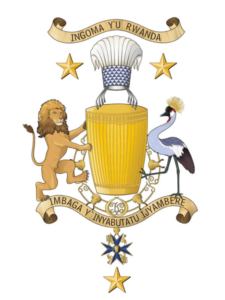Orders of Chivalry
De Jure Kingdom of Rwanda
The Kingdom of Rwanda, traditional East African state, now the Republic of Rwanda, is believed to have been settled by the Hutu sometime between the 5th and the 11th century and then by the Tutsi beginning in the 14th century. According to tradition, Ruganzu I Bwimba, a Tutsi leader, founded a kingdom in the Bwanacambwe region near Kigali in the 15th or 16th century. What is now central Rwanda was absorbed in the 16th century, and outlying communities were consolidated by the mwami (“king”) Ruganzu II Ndori in the 17th century. The borders of the kingdom were rounded out in the late 19th century by Mwami Kigeli IV Rwabugiri , who is regarded as Rwanda’s greatest mwami. By 1900 Rwanda was a unified state with a centralized military structure.
The Germans claimed Rwanda as part of German East Africa from 1890, but they never really controlled it. Following World War I it was assigned, along with neighboring Burundi, to Belgium as part of the League of Nations mandate of Ruanda-Urundi. The Belgians ruled through the traditional mwamis. Deteriorating conditions created by the Belgian colonial power forced Mwami Kigeli V into exile. He was later deposed, and in January 1961, Rwanda was declared a republic. Although Rwanda became an independent nation on July 1, 1962, Mwami Kigeli V never surrendered his crown. The royal family, with guidance from the Royal Council of Abiru, continues to function as a recognized monarchy in exile.
kings of rwanda
The Original country of Rwanda which is referred to the “Rwanda of Gasabo” was composed of a small territorial entity located in the present district of Gasabo, in the valley of Nyabugobo along Lake Muhazi
When the period of historical kings unfolded, Rwanda came under the reign of Mwami Ruganzu Bwimba who became the first mwami, one among a series of historical mwamis who ruled from the 14th to the 20th centuries. These mwamis belonged to one of the clans called Abanyiginya.
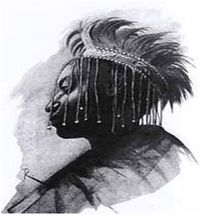
Kigeli IV Rwabugiri
Kigeli IV Rwabugiri was the king of the Kingdom of Rwanda in the late 19th century. He was among the last Nyiginya kings in a ruling dynasty that had traced their lineage back four centuries to Gihanga, the first ‘historical’ mwami of Rwanda whose exploits are celebrated in oral chronicles. He was the first mwami in Rwanda’s history to come into contact with Europeans. He established an army equipped with guns he obtained from Germans and prohibited most foreigners, especially Arabs, from entering his kingdom.
By the end of Mwami Rwabugiri’s rule, Rwanda was divided into a standardized structure of provinces, districts, hills, and neighborhoods, administered by a hierarchy of chiefs.
He defended the borders of the Rwandan kingdom against invading neighboring kingdoms, slave traders, and Europeans. Mwami Rwabugiri was a warrior king and is regarded as one of Rwanda’s most powerful kings. By the beginning of the 20th century, thanks to the efforts of Mwami Rwabugiri, Rwanda was a unified state with a centralized military structure.
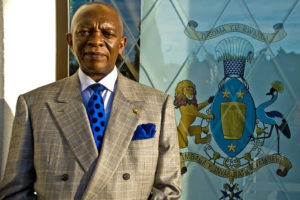
His Royal Majesty King Yuhi VI
His Royal Majesty King Yuhi VI is the current titular King of Rwanda. He was proclaimed the ceremonial successor to the royal title (Mwami) on 9 January 2017. He succeeded his late uncle King Kigeli V of Rwanda and is a grandson of Yuhi V. The accession of Yuhi VI was made by proclamation of the Royal Council of Abiru.
royal council of abiru
Royal Council of Abiru are a noble group of elders who function as advisors to the Mwami. Their primary function as a group is to determine the continuing suitability of the Mwami in terms of ritual and political function. Historically, the Abiru depose ‘unworthy’ kings and proclaim successors based on secretive ritual practices, acting as a fons honorum for Rwanda.
According to custom, the Council of Abiru are told by the Mwami of his choice of successor of the throne, which are selected from a pool of eligible males from the Royal line. They keep this selection a closely guarded secret, and only announce the choice after the Mwami’s death.
Charitable interests
His Majesty King Yuhi VI supports a diverse array of humanitarian programs, specifically universal human rights, cultural heritage, education, and agriculture and forestry modernization, in an effort to ensure the well-being of all Rwandan people worldwide. Many of His Majesty’s efforts are through the King Kigeli V Foundation, an organization which promotes humanitarian and educational projects for Rwandan refugees. People interested in obtaining additional information or making a donation are encouraged to contact the Assistant Chancellor of the Royal House of Rwanda at assistant-chancellor@royalhouseofrwanda.org.
orders of chivalry
With the exception of recognition of being a member of the Royal Guard, Royal Rwandan Orders convey noble status to recipients of the honor, regardless of grade. Recipients of honors, including that of the Royal Guard, are sometimes awarded a hereditary title which can be passed to the next generation. If granted, this would be an honor similar to a Baronet of the United Kingdom. Additionally, all recipients of knighthoods are authorized a heraldic coronet which can be displayed above the recipients coats of arms.
Royal Rwandan orders are based on rich history dating back centuries. Each order is based upon an honor which was traditionally bestowed on warriors by the mwami for his battlefield exploits. This section will provide a summary of that history.
Each section depicts the medal of the order, most commonly associated with the sash of the order, as well as one of the authorized chest badges of the order. The colors of the order are shown in ribbon form.
Royal Order of the Drum of Rwanda
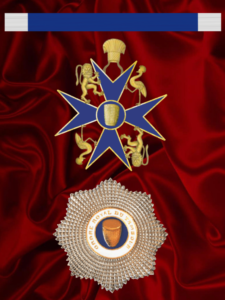
The power of the Mwami was symbolized by a large drum called the kalinga, which translates as “token of hope”. The kalinga was housed in a palace and protected at all times by a guard. It was thought that if the kalinga was ever lost or destroyed, the Rwandan nation would end. Only the nobles and royals of the Kingdom of Rwanda were allowed to touch the drum. Therefore, when His Majesty King Mutara III envisioned this Order in 1959, the drum was the most logical choice to represent the highest Order in the de jure Kingdom. H.M. King Kigeli V created the Order in 1959 and re-affirmed his right to grant this Order on the 3rd of January in 1998.
There are two ranks in the Royal Order of the Drum.
The higher rank is split into two parts, Grand Collar and Grand Cross, and the lower rank is Commander. A recipient of the Grand Collar is treated as an honorary member of the Royal House of Rwanda, while recipients of the Grand Cross and Commander are not. The Order may be granted as a hereditary award or as a non-hereditary honor. Nobility is conferred upon the grantee.
Style of the Chevalier/Dame- A recipient at the rank of Grand Collar or Grand Cross is entitled to the style of “His Excellency”. A recipient at the rank of Commander is entitled to the style of “The Honorable”.
Recipients of the Grand Collar wear a collar of gold chain linking alternating gold Crowns of Rwanda with the stylized initial ‘K’ (for Kigeli) with the medal of the order. Recipients of the Grand Cross wear the sash with medal of the order and a gold chest badge. Commanders of the order wear a silver chest badge.
Royal Order of the Crown of Rwanda
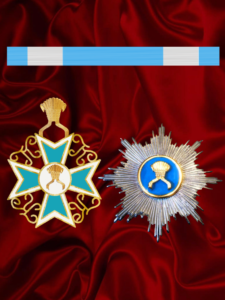
The Order of the Crown, the second-highest Order in the de jure Kingdom of Rwanda, is the inheritor of the tradition of the Gucana Uruti, the burning of the javelin. This was a Rwandan ceremony where the greatest warrior, a true national hero, was honored for having killed twenty-one enemies in combat under specific guidelines. Historically, the ceremony was held on the highest mountain near where the warrior lived.
This distinction granted the honoree the right to be treated as a member of the family of the reigning king. The decorated hero that had undergone Gucana Uruti was allowed to wear the crown of the Mwami when the Mwami was seated and not using it.
The Royal Order of the Crown (Ikamba in the native Kinyarwandan) was envisioned by H.M. King Mutara III in 1950, and it was formally instituted by his successor, Kigeli V, in 1959. In 1950, King Mutara III had his staff weave a miniature of the Crown of Rwanda as a gift for a state visit from another royal. This gift was a physical precedent for the Order, and it was also a prelude to its official introduction years later.
There are three ranks in the Order. The highest is Grand Collar, followed by Grand Cross, and the lowest rank is Commander. The Order may be granted as a hereditary award or as a non-hereditary honor. Nobility is conferred upon the grantee.
Recipients of the Grand Collar wear a a collar of gold chain linking alternating gold Crowns of Rwanda with the stylized initial ‘K’ (for Kigeli) with a medal of the order attached. Recipients of the Grand Cross wear a sash and medal of the order and a silver chest badge depicting a gold crown. Commanders of the order wear a silver chest badge depicting a silver crown.
Royal Order of the Crested Crane of Rwanda
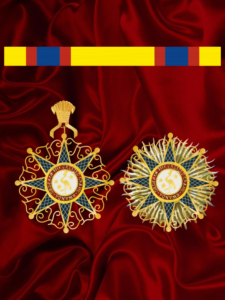
The Order of the Crested Crane (Usumbere in the native Kinyarwandan), the third-highest Order in the de jure Kingdom of Rwanda, is the inheritor of the Rwandan tradition called the Impotore, the torse bracelet. After a warrior killed his 14th enemy in combat, he was awarded this honor on the following conditions: the 14 kills had to be foreign adversaries killed in an authorized battle by the Mwami, and the deaths must occur on the field of war. The honor consisted of a bracelet formed from a leaf of iron and a leaf of brass. These were rolled together to form the twisted design of the torse. The torse bracelet was historically housed in a separate location and could not be placed on the ground as a sign of reverence. The torse bracelet could not be worn by a warrior concurrently with the necklace of the seventh, and the two items were required to be housed in different locations.
The Royal Order of the Crested Crane was created by H.M. King Mutara III as a continuation of the Impotore tradition. In the Kingdom of Rwanda, the award was granted with a feathered cap, which was a form of coronet. The Order was re-affirmed by H.M. King Kigeli V on the 3rd of January in 1998, and it is inspired by the national bird of Rwanda, the crested crane. The bird also serves as a supporter in H.M. King Kigeli V’s heraldry.
There are two ranks in the Order. The higher rank is Grand Cross, and the lower rank is Commander. The Order may be granted as a hereditary award or as a non-hereditary honor, although it is generally issued as a hereditary honor. Nobility is conferred upon the grantee.
Recipients of the Grand Cross wear a sash of the order and a chest badge. Commanders of the order wear a chest badge.
Royal Order of the Lion of Rwanda
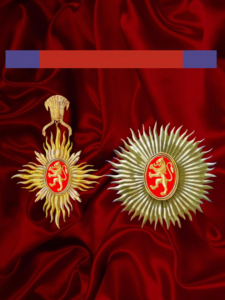
The Order of the Lion (Intare in the native Kinyarwandan language) is the lowest Order in the de jure Kingdom of Rwanda. It is the inheritor of the Rwandan Umudende ceremony, the necklace of the seventh. This was a Rwandan custom where a warrior was honored for having killed his seventh enemy in combat. The rules were similar to the aforementioned Impotore.
The historical distinction of the Umudende granted the recipient a necklace of iron that held small bells in an even number: two, four, or six bells were displayed at chest height. The necklace was historically protected in a separate house and could not be placed on the ground. Pre-conversion to Catholicism, the bells were regarded as a religious talisman that warded off evils spirits. The recipient was also awarded a lion’s pelt, and the investiture ceremony literally clothed the recipient in the pelt. This ritual demonstrated that the bravery of the grantee was akin to the lion, the king of beasts. The recipient was also expected to have a superior social status within the kingdom that would now be described as a noble class, and an annual tribute to the King was required with the regular sacrifice of a young bull. However, a decision of H.M. Kigeli Kigeli IV Rwabugili removed some of the earlier obligations of Umudende recipients to allow the honor to be accessible to heroes of modest fortune. Under precise rules regarding the conquest or liberation of other kingdoms, a King could also be decorated in this way.
King Yuhi V removed the killing requirements for the honor after Catholic missionaries and German colonists began their work, and this honor was granted to some of them.
There are five ranks in the Order. The highest rank is Grand Cross, which is followed by the Grand Officer rank. The third-highest rank is Knight Commander or Dame Commander, which is followed by the Officer rank. The lowest rank is the Knight or Dame rank. The Order may be granted as a hereditary award or as a non-hereditary honor. Nobility is conferred upon the grantee.
A recipient at the rank of Grand Cross is entitled to the style of “His Excellency”. A recipient at the rank of Grand Officer is entitled to the style of “The Honorable”. No other ranks in the Order are entitled to a style.
Order of the Lion Recipients of the Grand Cross wear a gold chest badge and sash of the order. Grand Officers of the order wear the neck order and a silver chest badge. Knight Commanders wear the neck order. Officers and Knights of the order wear a chest medal with ribbon of the order.
The Royal Guard
The Royal Guard is a historical continuation of a ceremonial guard that provides protection and service to H.M. the Mwami. Within the modern context of a title and honor, a grantee into the Royal Guard receives a hereditary knighthood or dameship, but the recipient does not belong to an Order. The Royal Guard is junior to all the official Orders of the de jure Kingdom of Rwanda. Nobility is not conferred upon the grantee. There is no regalia associated with this honor. However, a recipient is authorized a heraldic achievement as a member of this knightly class.
heraldry
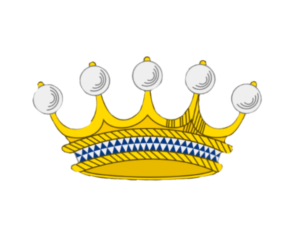
Heraldry is not a significant part of the historic cultural tradition of Rwanda, but there are some precedents. For example, His Majesty King Kigeli V has a heraldic achievement with a Bantu-style shield. The coronet for a Chevalier or Dame will be a gold coronet surmounted by eight balls of pearl. The band of the coronet will display white and blue beading similar to the Crown of Rwanda.
Grantees and inheritors of the noble title and honor may display their heraldry with a Bantu-style shield or else a heater-style shield, the above coronet, a helm, a torse, mantling or a manteau, and supporters or a combination of these. Recipients of the Order at any rank may, but are not required to, also display the kalinga drum on his or her escutcheon, but the design may not directly mimic the heraldry of His Majesty King Kigeli V or other future Heads of the Royal House. This prevention of mimicking the design of the Head of the Royal House ensures that the armiger is not accidentally mistaken for His Majesty the Mwami. In accordance with the original vision of H.M. King Mutara III, leopard skin may be used as a manteau. Grantees and inheritors also had the right, beginning with H.M. King Mutara III, to decorate their battle shields, and this is akin to a heraldic system.
This section was produced with the assistance and permission of His Royal Majesty King Yuhi VI. His majesty, as the de jure King of Rwanda, is dedicated to providing humanitarian support to Rwanda and Africa, as well to preserving the culture and traditions of a people dating to the beginning of the kingdom in the 5th century. For more information on the de jure Kingdom of Rwanda, the Orders of the Royal Household, or to inquire about ways to donate support His Majesty’s humanitarian activities, please visit the website of the Royal House of Rwanda at royalhouseofrwanda.org.
